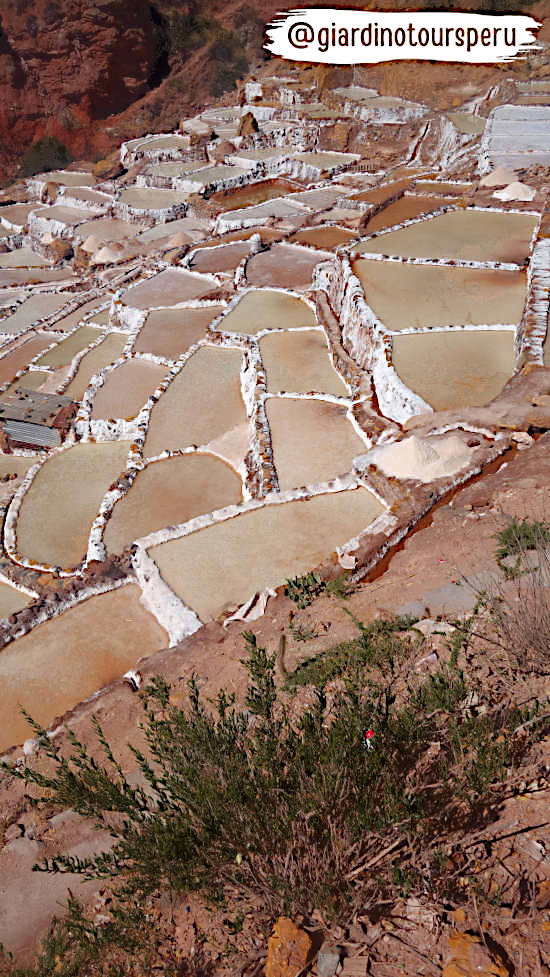Salineras of Maras is among the most spectacular sights in Cusco area, with thousands of salt pans that have been used for salt extraction since Inca times.
Since pre-Inca times, salt has been obtained in Maras by evaporating salty water from a local subterranean stream. The highly salty water emerges at a spring, a natural outlet of the underground stream. The flow is directed into an intricate system of tiny channels constructed so that the water runs gradually down onto the several hundred ancient terraced ponds.
Almost all the ponds are less than four meters square in area, and none exceeds thirty centimeters in depth.
All are necessarily shaped into polygons with the flow of water carefully controlled and monitored by the local workers.
Maras Salt Ponds
The Salt Mines of Maras are located 50 km in the northeast of Cusco city, at an altitude of 3,200 m.a.s.l. The salt mines themselves are constituted by a set of approximately 4,500 salt wells placed in the form of stepped terraces in the middle slope of the hill Qaqawiñay.
This hill has slopes of 20 degrees of inclination to the bottom of the gorge on the left bank of the Salineras stream, with dimensions that vary around 5 linear meters, occupying a total area of approximately 1.5 to 2 hectares (Silva Guerra, 2006:11).

The terraces are formed by retaining walls of irregular stone seated with mud mortar, forming dikes that delimit the wells as small reservoirs of approximately 5m2. The conduction system of the saltwater from its catchment, is done through a main irrigation channel, which branches out into several small channels that feed the wells. The conduction and maintenance of the saltwater channel is associated with a path that is assumed to be of prehispanic origin due to its layout and characteristics.
This technology is similar to that of irrigation in prehispanic agricultural terraces characterized by the conduction and equitable distribution of water. The upper part of the salt mines crosses a road, from the prehispanic time, in the direction of the K’arachaka (Half Moon) bridge. From this road, there are several branches for the circulation between the wells. The set of wells and canals is in perfect continuous operation from the pre-Inca period to the present (Silva, 2007:18).
It is notorious the very particular effect and its great landscape value that the set of stepped wells produces, being perceived as the total of numerous white, creams or browns squares, arranged with particular order.
They followed the topography of a slope of the Qaqawiñay hill, most of them looks flooded with water and other dry with salt on its surface, where the particular configuration of the set and the chromatic contrast with the natural environment provided with low shrub vegetation stand out.
The salt production takes place once a month and is marked by the calendar of the seasons of the year. Thus, in the dry season (from May to October) the accumulation of salt is fast, there is greater production, and a better quality of salt is obtained with a “white or pink color that characterizes commercially this salt”.
In the salt extraction and elaboration process predominate the traditional social relationships of communitarian type, keeping till the present its traditional way.
When and how to book Salinas de Maras
The best time to visit in in the dry Season (from March to October) and is the most recommended. If you prefer an organized tour, in every Cusco travel agency you will find offers for a Day Tour of the Sacred Valley, that include a visit to the Salineras de Maras or organized Tours to visit Maras and Moray (Group tours).
The area of Maras is located near to the Sacred Valley of the Incas; which makes it perfect for personalized activities in private Tours from Cusco or from Sacred valley such and Full day bikes excursions, hikings and customized tours with visit to Moray remains and then keep traveling to Machu Picchu.
The entrance fee to Maras is S/. 7 soles per persons (USD2,5) 🙂
Curious about this magnificent destination?
Come to Perú!
Giardino Team!
@Giardinotoursperu
#ItravelwithGiardino ‘OnetripManyExperiences

